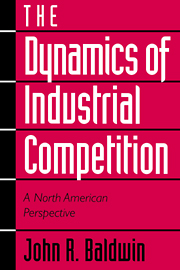Book contents
- Frontmatter
- Contents
- preface
- Acknowledgements
- 1 The dynamics of competition
- 2 Greenfield entry and closedown exit
- 3 Entry, exit, and the merger process
- 4 The rise and fall of incumbents
- 5 Patterns of large- and small-firm mobility
- 6 Plant turnover in Canada and the United States
- 7 Measures of market structure and the intensity of competition
- 8 The relationship between mobility and concentration
- 9 Turnover and productivity growth
- 10 Merger success
- 11 Turnover in domestic and foreign enterprises
- 12 Industry efficiency and firm turnover in the Canadian manufacturing sector
- 13 Firm turnover and profitability
- 14 Modelling entry
- 15 Conclusion
- Appendix A Measuring firm turnover – methodology
- Appendix B Definition of concentration and mobility measures
- Notes
- References
- Author index
- Subject index
2 - Greenfield entry and closedown exit
Published online by Cambridge University Press: 30 March 2010
- Frontmatter
- Contents
- preface
- Acknowledgements
- 1 The dynamics of competition
- 2 Greenfield entry and closedown exit
- 3 Entry, exit, and the merger process
- 4 The rise and fall of incumbents
- 5 Patterns of large- and small-firm mobility
- 6 Plant turnover in Canada and the United States
- 7 Measures of market structure and the intensity of competition
- 8 The relationship between mobility and concentration
- 9 Turnover and productivity growth
- 10 Merger success
- 11 Turnover in domestic and foreign enterprises
- 12 Industry efficiency and firm turnover in the Canadian manufacturing sector
- 13 Firm turnover and profitability
- 14 Modelling entry
- 15 Conclusion
- Appendix A Measuring firm turnover – methodology
- Appendix B Definition of concentration and mobility measures
- Notes
- References
- Author index
- Subject index
Summary
Most new firms are founded with an idea and for a definite purpose. The life goes out of them when that idea or purpose has been fulfilled or has become obsolete or even if, without having become obsolete, it has ceased to be new.
Joseph Schumpeter (1939: 69)Introduction
Economists have long focused on the process of entry and exit of firms. Many have emphasized its importance in facilitating the adaptation of industry to change. In the simplest of expositions, the acts of entry and exit serve to equate above- or below-normal profits with competitive rates. In other models, potential rather than actual entry serves to limit monopoly power. At one time included under the rubric of limit-pricing models, this argument has more recently been given theoretical elegance by contestability theory. The turnover that results from exit and entry is also seen as a conduit through which new ideas and innovations are introduced.
This view of entry is not shared by all. To some, the lack of entry indicates that entry is unimportant. Others have portrayed entry as an interesting but irrelevant curiosity. One such view depicts entrants as fringe firms that swarm into and out of an industry without having much impact. References to the entry and exit process as “hit-and-run” leave the impression, intentional or otherwise, of an unstable fringe that makes no contribution to such indicators of progress as productivity. Shepherd (1984), in a criticism of contestability theory, stresses that entry as an external force is usually secondary to internal conditions within an industry in determining the strength of competition.
- Type
- Chapter
- Information
- The Dynamics of Industrial CompetitionA North American Perspective, pp. 8 - 29Publisher: Cambridge University PressPrint publication year: 1995



